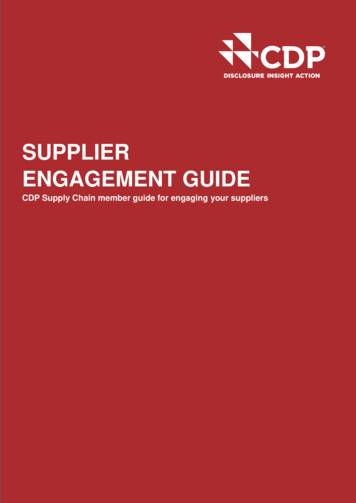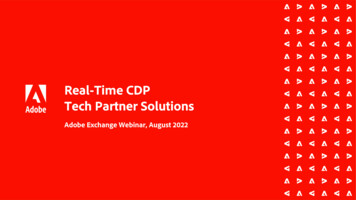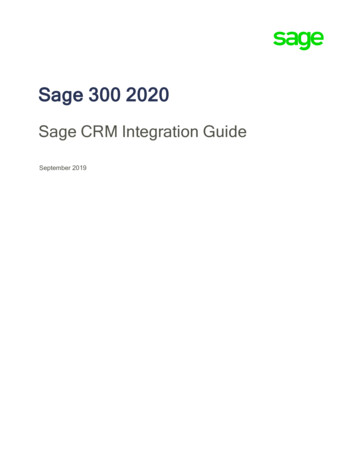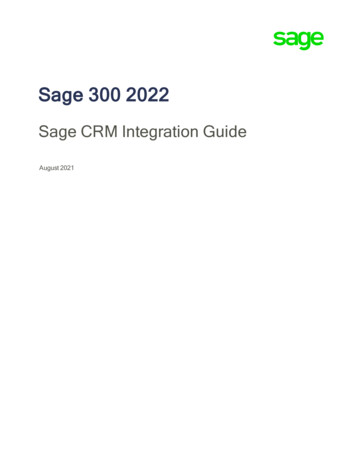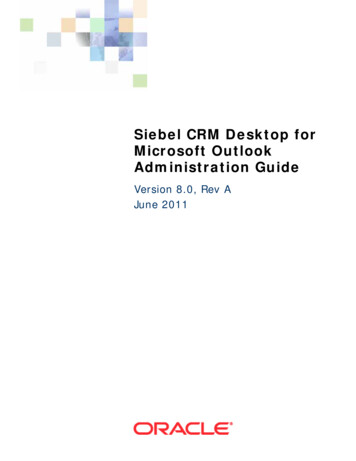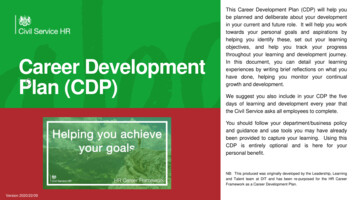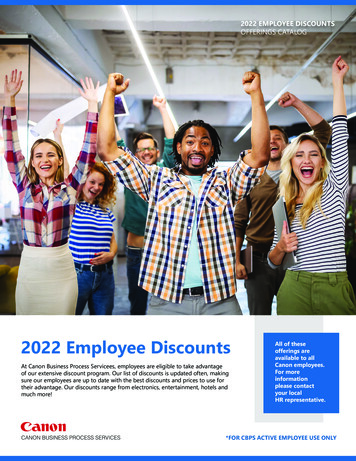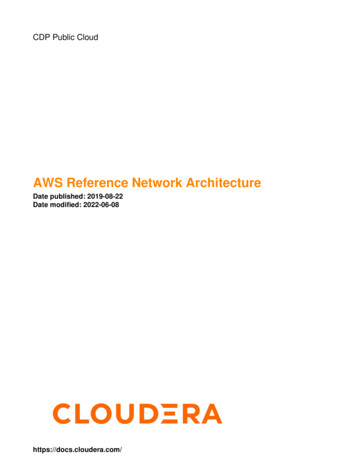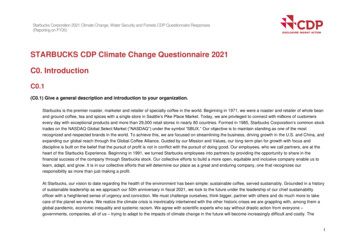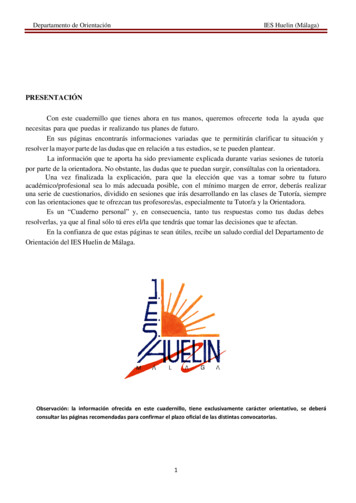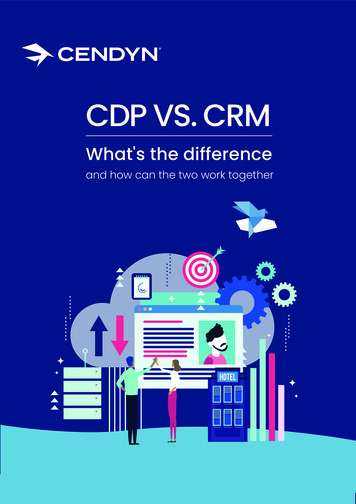
Transcription
CDP VS. CRMWhat's the differenceand how can the two work together
Setting the sceneWhen it comes to delivering experiences that turn one-offstays into repeat visits, data is a must-have. To build loyalty,your front-line staff needs recent and accurate information,available quickly at their fingertips. Marketing and sales teamsalso need data to do their jobs; from pipeline tracking tooptimizing marketing spend, data is critical to success.To collect this data and get it into the hands of staff, thecustomer relationship management, or CRM, has traditionallybeen the heart of the operation. It's been a shared source oftruth, relied on by any department that deals directly withguests. Over the past few years, a second data-focusedtechnology has become more commonplace: the customerdata platform, or CDP, which is a data layer that bridges acrossyour entire operation.This new addition to the acronym jargon can be confusing. It'sno surprise that these two technologies are easily mistaken forone other. They both focus on collecting, managing, and usingcustomer data to improve operations, marketing and sales. Whilethere are certainly overlaps, a few essential differences makethese two tools a must-have in any hotel marketing tech stack.With that in mind, let's compare customer data platforms withcustomer relationship management tools so that you can geta solid grasp on how both fit into your hotel’s technology needs.
What's the difference between a CDP and a CRM?The main difference between a CDP and CRM is right there in the name: aCDP manages customer data, and a CRM manages customer relationships.Of course, a CRM also collects customer data in its role as the go-to tool forcustomer-facing operations. It's the single source of truth that allows yourfront-line staff to deliver memorable experiences based on past behaviorand current preferences.When implemented, the CDP becomes the single source of truth across your entire operation.It’s the data foundation for all of your technologies, processes, and teams, as the CDPaggregates internal and external data and transforms that data into a standardized formatthat can be shared across applications. It builds its customer profiles from your hotel’s tools,such as your booking engine, website, email platform, marketing automation tool, and revenuemanagement software, as well as external data from social media, OTAs, and market trends.For a deep dive into customer data platforms, check out our guide here.The CDP then standardizes and normalizes all of this data so that your various technologiescan plug into the CDP to stay current. It's a two-way stream of information, keeping everythingthat's connected to the CDP in sync. Since this is automated in near-real-time, you’ll no longerrely on manual updates to sync information in different places -- or experience mismatchedinformation that limits your ability to personalize and optimize marketing at scale.Your CRM plugs into your CDP so that its data can be synchronized and shared. Your CRMcan then be enriched with whatever data sources you choose to connect into the CDP. Thisprocess makes your CRM more powerful, and able to accommodate new ways of working,marketing, and serving your guests.CDP vs CRMCDPCRMWhat is it?A standardized and normalized datalayer across touchpointsA centralized hub for logginginteractions to foster relationshipswith new and past customersWhat’s it for?Unify fragmented customer dataManage your customer relationshipsWhy?To understand your customers andtheir journeys so you can makedata-driven decisionsTo understand your customers andtheir journeys so you can makedata-driven decisionsLevel ofautomationFully automatedManual entry with some automationImplementationtimelineRequires some infrastructure tweaksto ensure everything is connectedproperlyRelatively fast, with easier integrationinto rest of operation
How does a CDP and CRM work together at your hotel?Your CDP doesn’t replace your CRM. In fact, it augments your CRM’s capabilities in a fewpowerful ways.Two-wayOutbound dataInbound dataRaw u'll notice a thread: it’s all about the dynamic augmentation of each customer touchpoint.Your CRM allows you to optimize the guest experience on-property and within the loyalty loop;a CDP amplifies that capability with its unified view of your customer journey.1.BETTER PERSONALIZATION WITH DYNAMIC CONTENTBy personalizing marketingcommunications based on inputs fromacross your operation, you can optimizeconversions with dynamic content that’smore relevant to an individual. It’s the holygrail of 1:1 marketing.The value of relevant, personalizedcommunications is measurable. All youneed to do is run a simple A/B experiment:as a control, use a generic abandonedcart email that simply asks the gueststo finish the booking. As the variable,build a dynamic abandoned cart emailthat pulls in the specific image of theroom that's in the abandoned cart. Then,measure the difference in conversionrate and correlate it with booking value tocalculate revenue lift. These CDP-enabledexperiments with dynamic content willaugment your CRM capabilities so thatyou can do more with the data youalready have.Improved personalization also impactssales, as your events team can use databeyond the customer profile to estimatecosts and build proposals that are bothprofitable and primed to convert.
2.MORE ROBUST SEGMENTATIONYour CDP tells you which ads are engaging which demographics. You can then usethat information to refine your segmentation around which demographics areinterested in specific offers. This optimized segmentation happens in near-real-time,updating as customers interact on your website and across your various marketingand distribution channels.One way to do that is to connect your CRM and your CDP to automatically import asegment of your best guests (the ones that spend the most at your hotel) into youradvertising platforms to build custom audiences. As your CRM updates with your bestguests’ latest lifetime values, you can sync your segmentation dynamically. That way,your marketing is optimized for continuous targeting of your ideal customers.
3.A FULLER PICTURE OF YOUR CUSTOMER JOURNEYYour CRM does a fantastic job at showing you everythingyou know about your guest relationships. Unfortunately, itgenerally starts at the first booking, which doesn't includethe complete path to purchase before that booking, andusually doesn't include touchpoints a customer may havehad in between stays.Let's say that a customer clicks on a Facebook ad to reacha specific offer for a romantic weekend getaway. Then, they sign up for anemail newsletter with a CTA of “Get the Best Deals.” Eventually, after openingyour newsletter six times, they finally book a single night stay. Your CRM logsthat information without necessarily showing the entire purchase path.By connecting your CDP and CRM, you’re able to augment your customerunderstanding so that you could personalize the email newsletter based onwhich ad the guest clicked. Then, a customer might only need to open oneemail to convert -- and you may end up selling a larger value package.A CDP gives you new ways to connect the dots across the customer journeyas well. You could recognize guests that may not be loyal to the hotel as anovernight guest but of its F&B outlets. When these types of frequent dinerscheck into your hotel for the first time, you can recognize them and push todeepen that relationship.
4.CLEAN DATA EVERYWHEREAnother major benefit of a CDP is the multiple waysof delivering clean, consolidated data across yourorganization.No matter where the touchpoint -- whether a datawarehouse, a third-party service provider or an internaldepartment -- a CDP ensures that the same data endsup in each touchpoint. This means that you’re able tobuild a data journey that matches your guest journeyprecisely and without redundancy. It future-proofs yourtech stack so that your CRM can continue to be thecentral source of guest information while still operatingflawlessly with tools you use today -- and those you’lluse in the future.Clean, synced data also means new recognitionopportunities. Imagine that an in-demand local wedding planner has just arrived at yourfront desk. His book of business could be worth six figures or more. Yet his profile is siloed inyour Sales and Catering system and your front desk isn’t aware of that status. The missedchance to recognize a valuable business partner could be a serious threat to futurebusiness opportunities!Ultimately, it comes down to improved visibility and alignment across teams. With theseinsights, every single team can make better decisions that are informed by data. Your marketing department understands which ads and offers work best. Revenue sees which rates trigger purchase intent from which segments. Front-line ops have a CRM with the most comprehensive guest profiles possible. Leadership has a clear picture of customer acquisition cost and guest lifetime value.It's kind of like an orchestra, with the CDP as the conductor: everything in harmony,synchronized and working together towards a common goal. And, like a good conductor, aCDP can integrate new players into your tech stack in a way that’s difficult for more traditionaltools. Since the data layer is standardized, it’s much easier to add new tools that supportemerging customer experiences – including things that you may not even envision in yourcurrent tech stack.
CDP or CRM: Which one is right for your hotel?For most hotels, it's not an either/or decision. Even smaller hotels and independents can benefitfrom the CDP’s data layer. Since they serve different purposes, hotels of all sizes can combinethe data-driven decision making enabled via the CDP with the CRM’s rich guest profiles toenhance the guest experience, optimize marketing spend, and operate more efficiently.If you find yourself struggling to keep data consistent across tools and channels, ormaintaining accurate guest profiles, then you may benefit from a customer data platform.With everything in sync, you’ll not only reduce frustrations across teams but also improvecollaboration and cohesiveness. You’ll have a leaner operation that makes more money withless effort - all while serving guests the seamless experiences they expect from your hotel.If you'd like more information about Cendyn's CDP, Starling,contact us today at info@cendyn.com orVISIT CENDYN.COM
customer relationship management tools so that you can get a solid grasp on how both fit into your hotel's technology needs. Setting the scene. The main difference between a CDP and CRM is right there in the name: a CDP manages customer data, and a CRM manages customer relationships.
